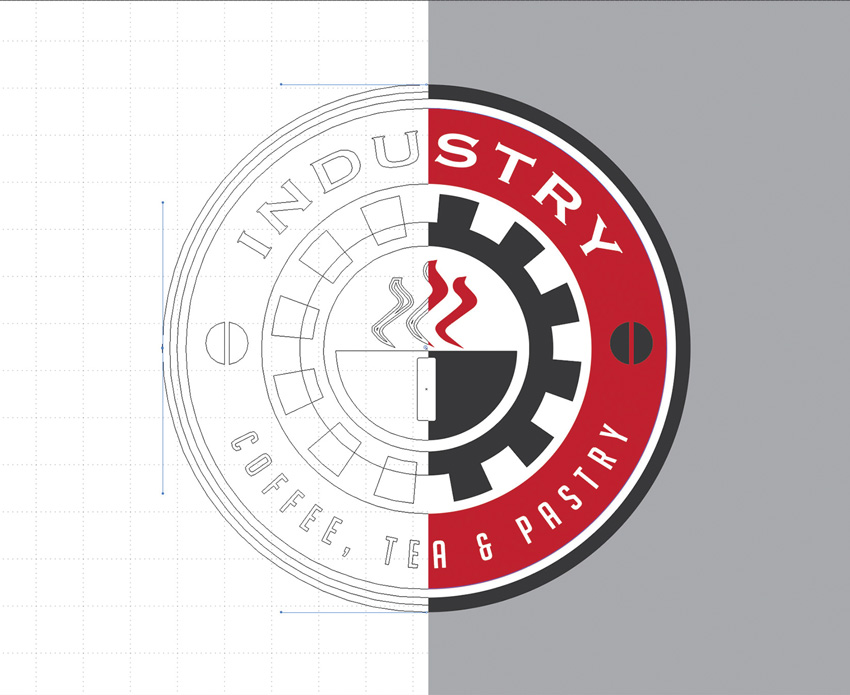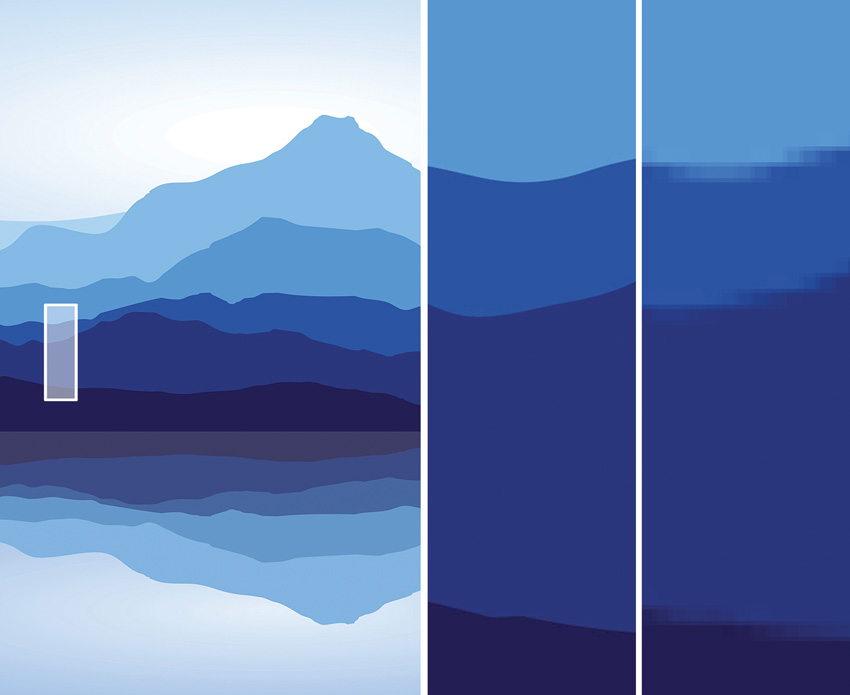Creative Potential of Vector Graphics for Architectural Glass Projects
An In-Depth Look at Vector Graphics
Because their potential is vast, it’s worth examining vector graphics in greater detail.
One of the key things to understand about vector graphics is how they differ from raster images. Before getting into the details, let’s start with some basic terminology.
Key Terminology
Raster (or bitmap) graphics are made up of tiny squares called pixels. Once a raster graphic is created at a certain size, meaning a fixed number of pixels, it cannot be scaled up without losing image quality. Digital photos are typically raster images.
A vector graphic is another type of digital image, but instead of pixels, it’s made of points and paths (lines between points) that are created through mathematical equations.
A pixel is the smallest addressable element in a display device. It is also a physical square in a raster image. Pixels are the smallest controllable elements of a picture represented on a display screen.
PPI stands for “pixels per inch” and is used to measure the resolution, or pixel density, of devices such as digital displays, image scanners, or digital-camera image sensors.
DPI stands for “dots per inch.” When used in reference to display screens, it is a measure of sharpness, or the density of illuminated points. When used in reference to printing, DPI refers to the measure of the printed image quality on paper, identifying the number of dots that can be placed within a 1-inch line.
Size refers to the number of pixels in an image along the width and height.
Resolution refers to the fineness of detail in an image and can be measured in PPI or DPI.
Vector Graphics
Vector graphics use mathematical equations to create infinitely scalable images by converting any graphic into points that are smoothly connected by lines and/or curves. These lines and curves are called “paths.” The paths are often filled in with color to make up the different shapes one sees in a vector graphic.

Vector graphics use mathematical equations to convert any graphic into points that are smoothly connected by lines and/or curves, also known as paths.
One of the main benefits of converting a graphic to path-connected points is that the resulting image can be infinitely scaled up or down without losing image quality or changing the file size.
Because of their scalability, vector graphics provide tremendous design flexibility. For example, if a company’s logo is created in a vector format, it can be used as small as a letterhead graphic or as large as a building feature wall.
Because file sizes do not change when vector graphics are scaled up or down, very large vector images retain a relatively small file size, which makes image processing, handling, and storage more manageable than with larger image file formats, including raster files.
This is not to say that vector graphics are always small files. File size is proportionally tied to the complexity of the vector image. A simple two-color logo might create a very small file, while the file for a process color illustration may be as large or larger than its corresponding raster image.
Commonly used vector formats are SVG, EPS, XML, and CGM.
Raster Images
Raster images are created from a finite number of tiny squares called pixels. Once a raster graphic is created at a certain size, meaning a fixed number of pixels, it cannot be scaled up without sacrificing image quality.
The greater the number of pixels in an image, the larger the file size, or resolution. While the two are positively correlated—a larger file size affords greater flexibility—the bottom line remains: raster graphics cannot be dramatically resized without compromising their resolution. If stretched to fit a space they were not designed to fill, their pixels become visibly grainy and the image distorts.
Because raster images are comprised of a finite number of pixels, increasing the image size also proportionally increases the pixel size. This results in degraded image resolution because the larger pixels are now more visible and contribute to the image looking blurry rather than crisp.
The use of raster images for large-scale design applications requires careful consideration. Both image size and resolution must be factored in to achieve optimal end results. This is critical for two reasons: 1) insufficient resolution can significantly compromise the quality of the end design; and 2) because large-scale raster images imply a large number of pixels and thus large file sizes, the images can be more difficult to process, handle, and store than alternate file formats, such as vector graphics.
To know whether a raster image can be used for an application, start by checking the pixel density. This density is measured in DPI or PPI. The PPI value is for digital displays of the image; the DPI value is for analog prints of the image. The PPI value is the same as the DPI value, but the terms should be properly applied based on the image display application.
For example: Web applications display images at 72 PPI and can look very crisp in that context. The Apple Retina display, however, is set at 227 PPI, so more modern technology would make this problematic. And even this DPI is still much too low for print applications, which require high-resolution raster files of around 300 DPI at actual output width and height.
Common raster file types are JPG, TIFF, PNG, GIF, and BMP.

When resized, infinitely scalable vector graphics (close-up at left) can offer a clearer picture than raster images (close-up at right).
The Advantages of Vector Graphics over Raster Images
There are many reasons to use vector graphics instead of raster images.
As we’ve just seen, there are three main challenges with raster imagery:
- Raster images cannot be resized without potentially sacrificing image quality or resolution.
- Raster images appropriate for use in large-scale applications are often difficult to source because personal and online stock photos, and even professional photography to a certain extent, do not usually have the dimensional resolution suitable for large-scale designs.
- Large, high-resolution raster images result in large file sizes that can be cumbersome to store, process, and produce.
By converting raster images to vector graphics, all of these challenges can be resolved:
- Vector images can be infinitely scaled up or down without losing image quality.
- Because vector graphics are flexible in terms of scaling, they can be customized for many different purposes, including large-scale projects and end uses. Again, while it is not uncommon to think of vector graphics largely for use in logos or branding elements, they have many potential applications.
- Vector art is ideal for printing. Since the art is made from a series of mathematical curves, it will print or otherwise output very crisply even when resized.
- When a vector image is scaled up to a larger size, the overall file size does not change. Large vector images can have a relatively small, easily managed file sizes.
Vector images are considerably more flexible than raster images and therefore much more beneficial in large-scale architectural applications.
That said, designers need to be aware that in converting raster images to vector graphics, the conversion process is more of a “translation,” and a vector graphic will never be a true one-to-one depiction of the original raster image.









